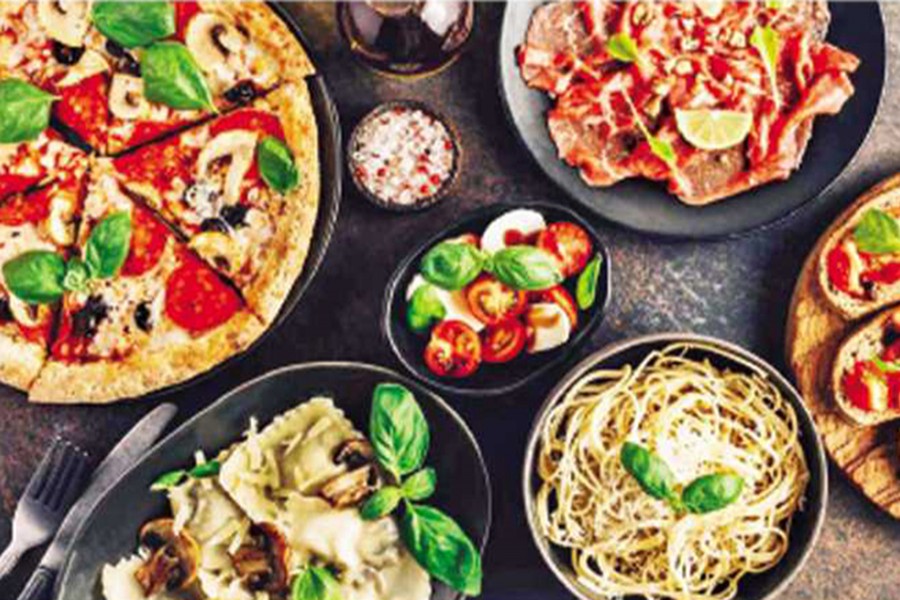The traditions of Italian food, art, music, architecture and literature are extensive. Italian cuisine is regarded as one of the world's best and most diversified ones. It is enriched with unique flavours, which will certainly tempt your taste buds and make you cherish it. Pizza, pasta, or spaghetti have become a part of our daily food habits.
All about Italian cuisine
There are many varied culinary traditions on the Italian peninsula, which result in a wide variety of Italian cuisine. For instance, Tuscany is most recognised for its straightforward yet rustic specialities, while Sicily creates seafood meals.
Italian cuisine is perhaps the most adapted cuisine, with endless fusions in many countries around the world-for instance, pizza and spaghetti, two common Italian dishes, are immensely popular among Americans.
The Italian culinary tradition also uses unique ingredients for each meal, including tomato, eggplant, pasta, cured meats, and cheese. The mouthwatering Italian desserts are unavoidable because they will bring your meal to a satisfying conclusion.
The most crucial thing to understand about Italian cuisine is that its traditional meals are produced with just a few basic components. However, these ingredients are carefully chosen, absolutely fresh and tender to use. Italians are known for using the best ingredients for their cooking. As the number of ingredients is few, they must be exceptional.
Characteristics
All fresh: Italian cuisine emphasises selecting high-quality, garden-fresh ingredients more than complex procedures, as mentioned already. Italy is a diversified country, and each region produces unique fruits, making it easily accessible all around the country. Italian cuisine, hence, is all about the rawness of all the ingredients they use in their meals, from eggs to oil, vegetables, meat, seafood, herbs, and cheeses.
Tradition: Italy has a long history. Each region has unique recipes combined skillfully with its traditions. Every place in Italy has a different food culture than the next.
For instance, more meat, potatoes, and rice are cooked in the north of Italy, which take slightly twisted changes in the neighbouring regions. In the centre of Italy, regional specialities like pizza and pasta are prevalent. While in the South, fresh tomatoes and fish are typically used in cooking. On the contrary, Sicily has been colonised by numerous cultures, greatly influencing its cooking methods. Only a handful of the things brought to the island by its inhabitants include tomatoes, almonds, and couscous.
Authentic Italian cuisine
Pizza: When it comes to Italian cuisine, pizza is a national symbol representing Italy to the rest of the world. Pizza makers have their own techniques, and each of the flour, water, brewer's yeast, and salt pizzas can have a variety of toppings or fillings added. The most famous and basic pizza is called 'Pizza Margherita,' made with tomato sauce, mozzarella, and basil, which are the Italian flag colours.
Pasta: Pasta is another symbol, a beloved global icon and a national dish for Italy. Rome, on the other hand, evolved into the city of spaghetti. This city has made 'Spaghetti Alla Carbonara' a globally popular choice. In the nation's capital, people also enjoy 'Bucatini al Cacio e Pepe,' a dish of pecorino cheese, butter, and pepper. The key is to combine them properly with precision. The 'Penne All'arrabbiata' pasta with a fiery tomato sauce is another well-known pasta dish.
Lasagna: Lasagne is another classic of Italian cuisine. The layers of fresh pasta in this baked dish, identical to Bologna, are topped with Béchamel sauce and the well-known 'Ragù Bolognese.' Pieces of beef and rich tomato are cooked gently and thoroughly in a sautéed celery, onion, and carrot sauce.
Tortelli and Ravioli: In Italy, stuffed pasta belongs to an extensive family. Nearly every region of Italy has its unique preparation. The 'Emilia Tortellini,' made of pork, Prosciutto, and Mortadella, are consumed with meat broth. The dry Tortelli comes in a larger rectangular shape, stuffed with herbs, pumpkin or potatoes, and served with butter and cheese; these are just a few examples of the popular ones.
Gnocchi: Gnocchi is another popular traditional Italian dish. Small potato dough circles are called Gnocchi. The most common ingredients are cheese, spinach, eggs, and a variety of sauces, though each location has its own version.
Gelato: Gelato is one of the desserts Italian cuisine can proudly distinguish itself from the world. Gelato is a unique kind of ice cream. Italians take great pleasure in having mastered the art of manufacturing ice cream. There are numerous tastes available.
Tiramisu: Along with gelato, one should also try tiramisu as a dessert. Even though the name has a slight Japanese touch, the dessert is Italian. Savoiardi biscuits serve as the base, which is topped with Mascarpone cream, eggs, sugar, and cocoa before being dipped in coffee and Marsala (a liqueur wine).
In Bangladesh
Italian cuisines arrived in Bangladesh long ago and have maintained a reserved fanbase. Since 1994, Spaghetti Jazz has been serving Italian cuisine in Dhaka. They may have been the first restaurant to serve thin-crust pizza made in the traditional Italian way.
There are some other restaurants that serve authentic Italian dishes. Raffinato Ristorante Italiano, Bella Italia, Pizza Roma, Villa Azzur, Sparrows, and O'play are top destinations for foodies who love Italian dishes. However, almost all of these restaurants are expensive.
Among others, pasta and pizza have become common and can be found in restaurants not specialised in Italian cuisines. There can also be seen numerous fusions, with Bengali cuisines blending with Italian taste. Cheez, Pizzaburg, Alfresco, Peri Pasta, Digggers, Street Oven, and Aloush are some remarkable places cooking Italian foods with a Bengali fusion.


